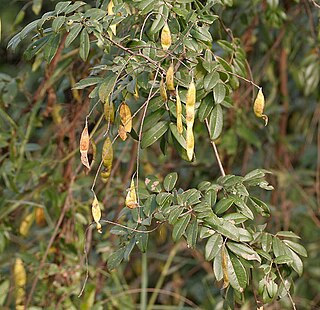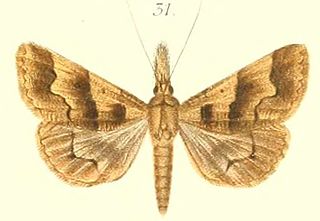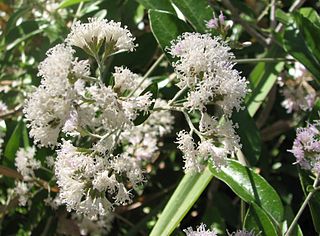
Terminalia elliptica is a species of Terminalia native to southern and southeast Asia in India, Nepal, Bangladesh, Myanmar, Thailand, Laos, Cambodia, and Vietnam. It is a prominent part of both dry and moist deciduous forests in southern India up to 1000 m.

Garrya is a genus of flowering plants in the family Garryaceae native to Mexico, the western United States, Central America and the Greater Antilles. Common names include silk tassel and tassel bush.

Derris is genus of leguminous plants found in Southeast Asia and the southwest Pacific islands, including New Guinea. The roots of D. elliptica contain rotenone, a strong insecticide and fish poison.

Garrya elliptica, the coast silk-tassel, silk tassel bush or wavyleaf silktassel, is a species of flowering plant in the family Garryaceae, native to the coastal ranges of California and southern Oregon. It is an erect, bushy, evergreen shrub reaching a height of 2–5 m (7–16 ft).
Ulmus ellipticaKoch is a disputed species of elm, native to the Caucasus, where Koch reported that it formed extensive woods, and ranging north to southern Ukraine. The tree is said to be closely related to U. glabra, but to resemble U. rubra in its samara. Many authorities consider U. ellipticaKoch just a regional form of U. glabra, though Henry, Bean and Krüssman list the Caucasus tree as a species in its own right. U. ellipticaKoch is distinguished from U. scabraMill. [:U. glabra] in some Armenian and Russian plant lists.

Ophyx is a genus of moths of the family Erebidae.

Persoonia elliptica, commonly known as snottygobble or spreading snottygobble, is a plant in the family Proteaceae and is endemic to the south-west of Western Australia. It is an erect shrub or small tree with egg-shaped or lance-shaped leaves and groups of cylindrical yellow flowers. It usually grows in woodland or forest dominated by jarrah or marri within 50 km (30 mi) of the coast.

Tarlmounia is a plant genus in the family Asteraceae. The sole species is Tarlmounia elliptica, native to India, Burma and Thailand and naturalised in southern Taiwan and Queensland, Australia. Common names include curtain creeper, vernonia creeper and parda bel.

Ophyx crinipes is a moth of the family Erebidae. It is found in Indonesia and Papua New Guinea.
Ophyx ochroptera is a moth of the family Erebidae first described by Achille Guenée in 1852. It is found in Australia, where it has been recorded from Queensland and New South Wales. The habitat consists of rainforests.

The Cocytiini are a tribe of moths in the family Erebidae. Adults of some members of the subfamily, especially in the genus Serrodes, have a proboscis capable of piercing fruit skins, allowing the moth to drink the fruit juice.
Ophyx pseudoptera is a moth of the family Erebidae first described by Oswald Bertram Lower in 1903. It is found in Papua, Papua New Guinea and Australia, where it has been recorded from Queensland. The habitat consists of lowland areas.
Ophyx bethunei is a moth of the family Erebidae first described by Jeremy Daniel Holloway in 1984. It is found on New Guinea. The habitat consists of mountainous areas.
Ophyx inextrema is a moth of the family Erebidae first described by Prout in 1926. It is found in Papua and on Buru in the Maluku Islands.
Ophyx owgarra is a moth of the family Erebidae first described by George Thomas Bethune-Baker in 1906. It is found in Papua and Papua New Guinea. The habitat consists of mountainous areas.
Ophyx eurrhoa is a moth of the family Erebidae. It is found in Australia, where it has been recorded from Queensland.
Ophyx bilinea is a moth of the family Erebidae. It is found in New Ireland.
Ophyx chionopasta is a moth in the family Erebidae. Endemic to Papua, Indonesia, it was first described by George Hampson in 1926.
Ophyx striata is a moth of the family Erebidae first described by George Hampson in 1926. It is found in Papua, Indonesia, where it has only been recorded from Fakfak, the type locality.
Ophyx talesea is a moth of the family Erebidae. It is found in New Britain.







